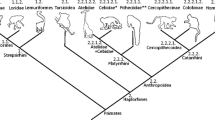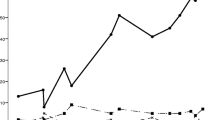Abstract
Anthropoidea is the suborder of Primates which includes New and Old World monkeys, apes, and humans. The term “Anthropoidea” was introduced by Mivart and has received general acceptance since Simpson (1945) included it in his classification of mammals (Simons, 1972). However, questions have arisen regarding the monophyletic nature of Anthropoidea. Since the fossil record relating to higher primate origins remains incomplete, there is reasonable doubt that the three superfamilies of Anthropoidea (Ceboidea, Cercopithecoidea, and Hominoidea) descended from a common “stem stock” (Schwartz et al., 1978). Although Simons (1976) views Anthropoidea as a monophyletic assemblage, he notes (1972) that the earliest putative ancestors of Ceboidea, Cercopithecoidea, and Hominoidea do not seem to resemble one another as much as one would expect if all had emerged from a single segment of Paleocene-Eocene lower primates.
Access this chapter
Tax calculation will be finalised at checkout
Purchases are for personal use only
Preview
Unable to display preview. Download preview PDF.
Similar content being viewed by others
References
Beard, J. M. and Goodman, M., 1976, The hemoglobins of Tarsius bancanus, in: Molecular Anthropology ( M. Goodman and R. E. Tashian, eds.), pp. 239–253, Plenum Press, New York.
Chiarelli, B., 1966, Karyology and taxonomy of the catarrhine monkeys, Am. J. Phys. Anthropol. 24: 155–170.
Cronin, J. E., and Sarich, V. M., 1975, Molecular systematics of the New World monkeys, J. Hum. Evol. 4: 357–375.
Dene, H. T., Goodman, M., and Prychodko, W., 1976, Immunodiffusion evidence on the phylogeny of the Primates, in: Molecular Anthropology ( M. Goodman and R. E. Tashian, eds.), pp. 171–195, Plenum Press, New York.
Dietz, R. S., and Holden, J. C., 1970, Reconstruction of Pangea: Breakup and dispersion of continents, Permian to Present, J. Geophys. Res. 75: 4939–4955.
Fitch, W. M., 1976, Molecular evolutionary clocks, in: Molecular Evolution ( F. J. Avala, ed.), pp. 162–178, Sunderland, Sinaeur, Massachusetts.
Gadow, H., 1898, A Classification of Vertebrates, Recent and Extinct, Black, London.
Gingerich, P. D., 1973, Anatomy of the temporal bone in the Oligocene anthropoid Apidium and the origin of the Anthropoidea, Folia Primatol. 19: 239–337.
Gingerich, P. D., 1976a, Phylogeny reconstruction and the phylogenetic position of Tarsius, in: Recent Advances in Primatology, Vol. 3, Evolution ( D. J. Chivers and K. A. Joysy, eds.), pp. 249–255, Academic Press, New York.
Gingerich, P. D., 19766, Cranial anatomy and evolution of early Tertiary Plesiadapidae (Mammalia, Primates), Mus. Paleontol. Univ. Mich. Papers Paleontol. 15: 1–141.
Goodman, M., 1973, The chronicle of primate phylogeny contained in proteins, Symp. Zool. Soc. Lond. 133: 339–375.
Goodman, M., 1974, Biochemical evidence on hominid phylogeny, Ann. Rev. Anthropol. 3: 203–228.
Goodman, M., 1976, Toward a genealogical description of the primates, in: Molecular Anthropology ( M. Goodman and R. E. Tashian, eds.), pp. 321–353, Plenum Press, New York.
Goodman, M., and Moore, G. W., 1971, Immunodiffusion systematics of the primates. I. The Catarrhini, Syst. Zool. 20: 19–62.
Goodman, M., Fariis, W., Moore, G. W., Prychodko, W., and Sorenson, M. W., 1974, Immunodiffusion systematics of the primates. II. Findings on Tarsius, Lorisidae, and Tupaiidae, in: Prosimian Biology ( R. D. Martin, G. A. Doyle, and A. C. Walker, eds.), Duckworth, London.
Goodman, M., Moore, G. W., and Matsuda, G., 1975, Darwinian evolution in the genealogy of hemoglobin, Nature 253: 603–608.
Goodman, M., Czelusniak, J., Moore, G. W., Romero-Herrera, A. E., and Matsuda, G., 1979, Fitting the gene lineage into its species lineage: A parsimony strategy illustrated by dado-grams constructed from globin sequences, Syst. Zool. 28: 132–163.
Haffer, J., 1970, Geologic climatic history and zoogeographic significance of the Uraba region in northwestern Colombia, Caldasia 10: 603–636.
Hamerton, J. L., 1963, Primate chromosomes, Symp. Zool. Soc. London 10: 221–219.
Harrington, H. J., 1962, Paleogeographical development of South America, Bull. Am. Assoc. Petrol. Geol. 46: 1173–1814.
Hennig, W., 1966, Phylogenic Systematics, University of Illinois Press, Urbana.
Hershkovitz, P., 1968, The recent mammals of the Neotropical region: A zoogeographic and ecological review, in: Evolution, Mammals, and Southern Continents ( A. Keast, R. C. Erk, and B. Glass, eds.), pp. 311–431, State University of New York Press, Albany.
Hershkovitz, P., 1974, A new genus of Late Oligocene monkey (Ceboidea, Platyrrhini) with notes on postorbital closure and platyrrhine evolution, Folia Primatol. 21: 1–35.
Hill, W. C. 0., 1955, Primates: Comparative Anatomy and Taxonomy. Vol. II. Haplorhini: Tarsioidea, University of Edinburgh Press, Edinburgh.
Hill, W. C. 0., 1957, Primates: Comparative Anatomy and Taxonomy. Vol. III. Pithecoidea, University of Edinburgh Press, Edinburgh.
Hill, W. C. 0., 1960, Primates: Comparative Anatomy and Taxonomy. Vol. IV, Platyrrhini, Cebidae, Part A, University of Edinburgh Press, Edinburgh.
Hill, W. C. 0., 1962, Primates: Comparative Anatomy and Taxonomy. Vol. V, Platyrrhini, Cebidae, Part B, University of Edinburgh Press, Edinburgh.
Hoffstetter, R., 1972, Relationships, origins, and history of the ceboid monkeys and caviomorph rodents: A modern reinterpretation, in: Evolutionary Biology, Vol. 6 ( Th. Dobzhansky, M. K. Hecht, and W. C. Steere, eds.), pp. 323–347, Appleton-Century-Crofts, New York.
Hoffstetter, R., 1974, Phylogeny and geographical deployment of the primates, J. Hum. Evol. 3: 327–350.
Holmquist, R., Jukes, T. H., Moise, H., Goodman, M., and Moore, G. W., 1976, Evolution of globin family genes, convergence of stochastic and augmented maximum parsimony genetic distance for alpha hemoglobin, beta hemoglobin and myoglobin phylogenies, J. Mol. Biol. 105:39–74.
Hoyer, B. H., and Roberts, R. B., 1967, Studies of nucleic acid interactions using DNA-agar, in: Molecular Genetics, Part II. U. H. Taylor, ed.), pp. 425–479, Academic Press, New York.
Klinger, H., 1963, The somatic chromosomes of some primates: Tupaia glis, Nycticebus coucang, Tarsius bancanus, Cercocebus aterrimus, Symphalangus syndactylus, Cytogenetics 2: 140–151.
Klinger, H., Hamerton, J. L., Mutton, D., and Lasig, E. M., 1963, The chromosomes of the Hominoidea, in: Classification and Human Evolution ( S. L. Washburn, ed.), pp. 235–242, Aldine, Chicago.
Kohne, D. E., 1970, Evolution of higher organism DNA, Quart. Rev. Biophys. 3: 327–375.
Kohne, D. E., Chiscon, J. A., and Hoyer, B. H., 1972, Evolution of primate DNA sequences, J. Hum. Evol. 1: 627–644.
Le Gros Clark, W. E., 1959, The Antecedents of Man, University of Edinburgh Press, Edinburgh.
Moore, G. W., 1971, A Mathematical Model for the Construction of Cladograms, Inst. Stat. Mimeograph Ser. 731, North Carolina State University, Raleigh.
Moore, G. W., Barnabas, J., and Goodman, M., 1973, A method for constructing maximum parsimony ancestral amino acid sequences on a given network, J. Theor. Biol. 38: 459–485.
Moore, G. W., Goodman, M., Callahan, C., Holmquist, R., and Herbert, M., 1976, Estimation of superimposed mutations in the divergent evolution of protein sequences: Stochastic vs. augmented maximum parsimony method-cytochrome C, J. Mol. Biol. 26: 111.
Olson, E. C., 1964, The geology and mammalian faunas of the Tertiary and Pleistocene of South America, Am. J. Phys. Anthropol. 22: 217–226.
Orlosky, F.J., and Swindler, D. R., 1975, Origins of New World monkeys, J. Hum. Evol. 4: 77–83.
Patterson, B., and Pascual, R., 1968, The fossil mammal fauna of South America, in: Evolution, Mammals and Southern Gmtinents ( A. Keast, R. C. Erk, and B. Glas, eds.), pp. 247–310, State University of New York Press, Albany.
Pocock, R. L., 1918, On the external characters of lemurs and Tarsius, Proc. Zool. Soc. London, 1918: 19–53.
Ramsay, A. T. S., 1971, A history of the formation of the Atlantic Ocean, Adv. Scientist 27: 239–249.
Romer, A. S., 1966, Vertebrate Paleontology, University of Chicago Press, Chicago.
Romero-Herrera, A. E., Lieska, N., Goodman, M.,and Simons, E. L., 1979, The use of amino acid sequence analysis in assessing evolution: A critique, Biochimie 61: 767–779.
Sarich, V. M., 1970, Primate systematics with special reference to Old World monkeys, in: Old World Monkeys: Evolution, Systematics and Behavior ( J. R. Napier and P. H. Napier, eds.), pp. 175–266, Academic Press, New York.
Sarich, V. M., and Cronin, J. E., 1976, Molecular systematics of the primates, in: Molecular Anthroplogy ( M. Goodman and R. E. Tashian, eds.), pp. 141–170, Plenum Press, New York.
Schwartz, J. H., Tattersall, I., and Eldredge, N., 1978, Phylogeny and classification of the primates revisited, Yearb. Phys. Anthropol. 21: 95–133.
Simons, E. L., 1961, The dentition of Ourayia: Its bearing on relationships of omomyid prosimians, Postilla 54: 1–20.
Simons, E. L., 1972. Primate Evolution, Macmillan, New York.
Simons, E. L., 1976. The fossil record of primate phylogeny, in: Molecular Anthropology ( M. Goodman and R. E. Tashian, eds.), pp. 35–60, Plenum Press, New York.
Simpson, G. G., 1945, The principles of classification and a classification of mammals, Bull. Am. Mus. Nat. Hist. 85: 1–350.
Tashian, R. E., Goodman, M., Ferrell, R. E., and Tanis, R. J., 1976, Evolution of carbonic anhydrase in primates and other mammals, in: Molecular Anthropology ( M. Goodman and R. E. Tashian, eds.), pp. 301–319, Plenum Press, New York.
Von Koenigswald, G. H. R., 1968, The phylogenetic position of the Hylobatinae, in: Taxonomy and Phylogeny of Old World Primates with References to the Origin of Man ( B. Chiarelli, ed.), pp. 271–276, Rosenberg and Sellier, Torino.
Whitmore, F. C., and Stewart, R. A., 1965, Miocene mammals and Central American seaways, Science 148: 180–185.
Wilson, J. A., 1966, A new primate from the earliest Oligocene, West Texas: Preliminary report, Folia Primatol. 4: 227–248.
Wilson, A. C., Carlson, S. S., and White, T. J., 1977, Biochemical evolution, Annu. Rev. Biochem. 46: 573–639.
Woodring, W. P., 1954, Caribbean land and sea through the ages, Bull. Geol. Soc. Am. 65: 719–732.
Author information
Authors and Affiliations
Editor information
Editors and Affiliations
Rights and permissions
Copyright information
© 1980 Plenum Publishing Corporation
About this chapter
Cite this chapter
Baba, M., Darga, L., Goodman, M. (1980). Biochemical Evidence on the Phylogeny of Anthropoidea. In: Ciochon, R.L., Chiarelli, A.B. (eds) Evolutionary Biology of the New World Monkeys and Continental Drift. Advances in Primatology. Springer, Boston, MA. https://doi.org/10.1007/978-1-4684-3764-5_21
Download citation
DOI: https://doi.org/10.1007/978-1-4684-3764-5_21
Publisher Name: Springer, Boston, MA
Print ISBN: 978-1-4684-3766-9
Online ISBN: 978-1-4684-3764-5
eBook Packages: Springer Book Archive




